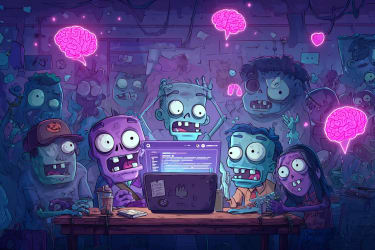
The Best Thing Since Browser-Based Code Challenges
When I first learned to code, everything started in the browser. At that time, I didn’t even know what an IDE was, but Windows had some text app that allowed you to save files as .html. It was magical, taking various pages from Yahoo.com and saving them to a folder, then altering them to create my own version. The web was different then, what you were seeing in production was also what was being written and saved on servers. That changed over time, so learning had to as well.
Back at Envy Labs, Gregg Pollack and Eric Allam built something wild for its time. They created a way to learn and write Ruby on Rails right in the browser. No local dev setup, no terminal, no installs. Just you, a video lesson, and instant feedback on what you were doing. Their solution changed learning in the browser to being taught in the browser.
That moment changed my life. I started attending course launches, met the team at those and conferences, and eventually joined the company. It led me to a career, to teaching, and eventually to DataCamp, where we try to keep that same spark alive.
Now, it’s happening again.
DataCamp just announced the acquisition of Optima, bringing AI-native, personalized learning into reality. If browser-based coding broke the barrier of setup, this breaks the barrier of sameness.
I haven’t been this excited about anything in online education since that initial work from Gregg and Eric. I was especially fond of it because we were teaching the things I also did on a daily basis, but Code School made learning feel alive. You typed, you tried, you failed, and you learned. It was direct and human. Since then, online education has grown up, but much of it still feels the same.
The new work at DataCamp has that special feeling again. We made data and AI learning interactive. Now we’re making it personal. The line that has me dreaming is this: Every lesson, challenge, and example is generated in real-time to adapt to who you are. That’s the big shift. Lessons that change based on what you know, where you struggle, and what you’re trying to do.
It’s a rebuild of how online education works. Video-based learning with a code box in the browser initially felt human. Still, over the years, I’ve seen countless comments from people wanting some form of communication available while taking courses. Now, text in a box doesn’t feel human, but it does feel personal. Your roles and reasons for taking the course are referenced, the tone shifts slightly to match your communication style. It starts to feel like a conversation.
Why It Matters Now
The pace of change in tech is faster than static lessons can handle. By the time a course ships, half of it is outdated. Browser-based challenges were a reaction to tooling complexity, adaptive learning is a reaction to a rapid technology releases. These systems will be able to meet you where you are and adjust to how you move.
I hope we keep the human side in focus. Having met the Optima team, I have zero concerns about that, but AI is expensive in many ways, and this is a business after all. I think for DataCamp and many other companies, it will be a matter of figuring out how to push the limits of what’s possible without breaking the bank.
The dream is a platform that knows what you need, skips what you don’t, and keeps you moving without wasting your time. If we get that balance right, people won’t just be learning faster. We’ll all be learning smarter.
Closing Thoughts
The first time I saw code run in a browser, I knew things would never be the same. This feels like that again. We’re all still learning how to learn. But now, the tools are starting to learn with us.
If you want to give it a spin, check out the available courses.